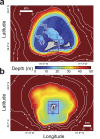Many Atolls May be Uninhabitable Within Decades Due to Climate Change
- PMID: 26403195
- PMCID: PMC4585922
- DOI: 10.1038/srep14546
Many Atolls May be Uninhabitable Within Decades Due to Climate Change
Abstract
Observations show global sea level is rising due to climate change, with the highest rates in the tropical Pacific Ocean where many of the world's low-lying atolls are located. Sea-level rise is particularly critical for low-lying carbonate reef-lined atoll islands; these islands have limited land and water available for human habitation, water and food sources, and ecosystems that are vulnerable to inundation from sea-level rise. Here we demonstrate that sea-level rise will result in larger waves and higher wave-driven water levels along atoll islands' shorelines than at present. Numerical model results reveal waves will synergistically interact with sea-level rise, causing twice as much land forecast to be flooded for a given value of sea-level rise than currently predicted by current models that do not take wave-driven water levels into account. Atolls with islands close to the shallow reef crest are more likely to be subjected to greater wave-induced run-up and flooding due to sea-level rise than those with deeper reef crests farther from the islands' shorelines. It appears that many atoll islands will be flooded annually, salinizing the limited freshwater resources and thus likely forcing inhabitants to abandon their islands in decades, not centuries, as previously thought.
Figures





References
-
- Merrifield M. A., Merrifield S. T. & Mitchum G. T. An anomalous recent acceleration of global sea-level rise. J Clim 22, 5772–5781 (2009).
-
- Jevrejeva S., Grinsted A. & Moore J. C. Anthropogenic forcing dominates sea-level rise since 1850. Geophys Res Lett 36, L20706 (2009).
-
- Milne G. A., Gehrels W. R., Hughes C. W. & Tamisiea M. E. Identifying the causes of sea-level change. Nat Geosci 2, 471–478 (2009).
-
- Grinsted A., Moore J. C. & Jevrejeva S. Reconstructing sea level from paleo and projected temperatures 200 to 2100 AD. Clim Dynam 34, 461–472 (2009).
Publication types
MeSH terms
LinkOut - more resources
Full Text Sources
Other Literature Sources
Medical

